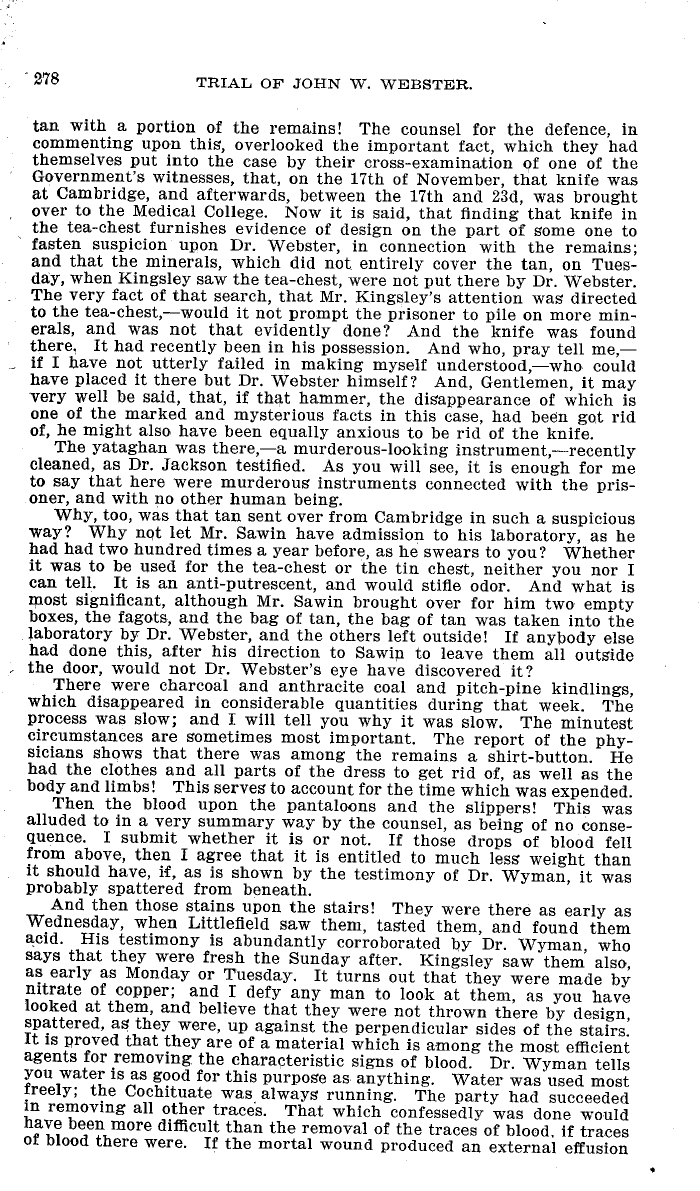|
278 TRIAL OF JOHN W. WEBSTER.
tan with a portion of the remains! The counsel for the defence, in
commenting upon this, overlooked the important fact, which they had
themselves put into the case by their cross-examination of one of the
Government's witnesses, that, on the 17th of November, that knife was
at Cambridge, and afterwards, between the 17th and 23d, was brought
over to the Medical College. Now it is said, that finding that knife in
the tea-chest furnishes evidence of design on the part of some one to
fasten suspicion upon Dr. Webster, in connection with the remains;
and that the minerals, which did not entirely cover the tan, on Tues-
day, when Kingsley saw the tea-chest, were not put there by Dr. Webster.
The very fact of that search, that Mr. Kingsley's attention was directed
to the tea-chest,-would it not prompt the prisoner to pile on more min-
erals, and was not that evidently done? And the knife was found
there, It had recently been in his possession. And who, pray tell me,-
if I have not utterly failed in making myself understood,-who could
have placed it there but Dr. Webster himself? And, Gentlemen, it may
very well be said, that, if that hammer, the disappearance of which is
one of the marked and mysterious facts in this case, had been got rid
of, he might also have been equally anxious to be rid of the knife.
The yataghan was there,--a, murderous-looking instrument,-recently
cleaned, as Dr. Jackson testified. As you will see, it is enough for me
to say that here were murderous instruments connected with the pris-
oner, and with no other human being.
Why, too, was that tan sent over from Cambridge in such a suspicious
way? Why not let Mr. Sawin have admission to his laboratory, as he
had had two hundred times a year before, as he swears to you? Whether
it was to be used for the tea-chest or the tin chest, neither you nor I
can tell. It is an anti-putrescent, and would stifle odor. And what is
most significant, although Mr. Sawin brought over for him two empty
boxes, the fagots, and the bag of tan, the bag of tan was taken into the
laboratory by Dr. Webster, and the others left outside! If anybody else
had done this, after his direction to Sawin to leave them all outside
the door, would not Dr. Webster's eye have discovered it?
There were charcoal and anthracite coal and pitch-pine kindlings,
which disappeared in considerable quantities during that week. The
process was slow; and I will tell you why it was slow. The minutest
circumstances are sometimes most important. The report of the phy-
sicians shows that there was among the remains a shirt-button. He
had the clothes and all parts of the dress to get rid of, as well as the
body and limbs! This serves to account for the time which was expended.
Then the blood upon the pantaloons and the slippers! This was
alluded to in a very summary way by the counsel, as being of no conse-
quence. I submit whether it is or not. If those drops of blood fell
from above, then I agree that it is entitled to much less weight than
it should have, if, as is shown by the testimony of Dr. Wyman, it was
probably spatterd from beneath.
And then those stains upon the stairs! They were there as early as
Wednesday, when Littlefield saw them, tasted them, and found them
acid. His testimony is abundantly corroborated by Dr. Wyman, who
says that they were fresh the Sunday after. Kingsley saw them also,
as early as Monday or Tuesday. It turns out that they were made by
nitrate of copper; and I defy any man to look at them, as you have
looked at them and believe that they were not thrown there by design,
spattered, as they were, up against the perpendicular sides of the stairs.
It is proved that they are of a material which is among the most efficient
agents for removing the characteristic signs of blood. Dr. Wyman tells
you water is as good for this purpose as anything. Water was used most
freely; the Cochituate was. always running. The party had succeeded
in removing all other tracs. That which confessedly was done would
have been more difficult than the removal of the traces of blood, if traces
of blood there were. If the mortal wound produced an external effusion
|

